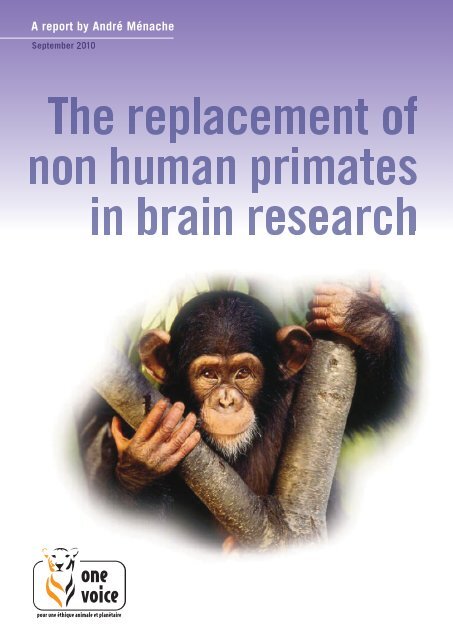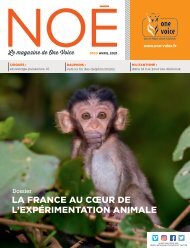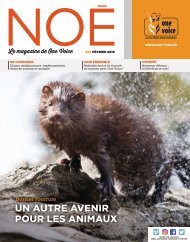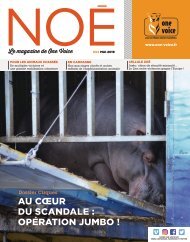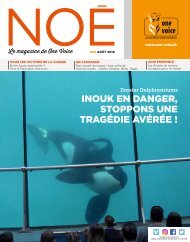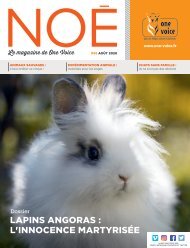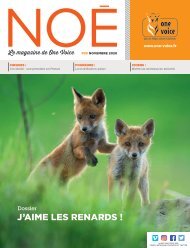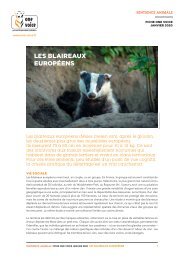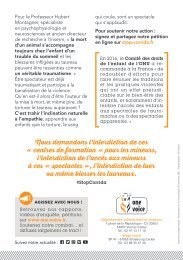The replacement of non human primates in brain research
You also want an ePaper? Increase the reach of your titles
YUMPU automatically turns print PDFs into web optimized ePapers that Google loves.
A report by André Ménache
Contents<br />
Foreword . . . . . . . . . . . . . . . . . . . . . . . . . . . . . . . . . . . . . . . . . . . . . . . . . . . . . . . . . . . . . . . . . . . . . . . . . . . . . . . . . . . . . . . . . . . . . . . . . . . . . . . . . . . . . . . . . . . . . . . . . . . . . . . . 3<br />
<strong>The</strong> author . . . . . . . . . . . . . . . . . . . . . . . . . . . . . . . . . . . . . . . . . . . . . . . . . . . . . . . . . . . . . . . . . . . . . . . . . . . . . . . . . . . . . . . . . . . . . . . . . . . . . . . . . . . . . . . . . . . . . . . . . . . . . . 4<br />
Preface . . . . . . . . . . . . . . . . . . . . . . . . . . . . . . . . . . . . . . . . . . . . . . . . . . . . . . . . . . . . . . . . . . . . . . . . . . . . . . . . . . . . . . . . . . . . . . . . . . . . . . . . . . . . . . . . . . . . . . . . . . . . . . . . 5<br />
Introduction . . . . . . . . . . . . . . . . . . . . . . . . . . . . . . . . . . . . . . . . . . . . . . . . . . . . . . . . . . . . . . . . . . . . . . . . . . . . . . . . . . . . . . . . . . . . . . . . . . . . . . . . . . . . . . . . . . . . . . . . . . . . 7<br />
<strong>The</strong> <strong>human</strong> bra<strong>in</strong> versus the <strong>non</strong> <strong>human</strong> primate bra<strong>in</strong> - structural and functional differences . . . . . . . . 7<br />
Examples <strong>of</strong> experimental protocols on <strong>non</strong> <strong>human</strong> <strong>primates</strong> <strong>in</strong>volv<strong>in</strong>g <strong>in</strong>vasive procedures<br />
- ethical and welfare issues . . . . . . . . . . . . . . . . . . . . . . . . . . . . . . . . . . . . . . . . . . . . . . . . . . . . . . . . . . . . . . . . . . . . . . . . . . . . . . . . . . . . . . . . . . . . . . . . . . . . . 10<br />
Examples <strong>of</strong> current NHP models for the study <strong>of</strong> <strong>human</strong> conditions . . . . . . . . . . . . . . . . . . . . . . . . . . . . . . . . . . . . . . . . . . 13<br />
Cognitive neuroscience . . . . . . . . . . . . . . . . . . . . . . . . . . . . . . . . . . . . . . . . . . . . . . . . . . . . . . . . . . . . . . . . . . . . . . . . . . . . . . . . . . . . . . . . . . . . . . . . . . . . . . . . . . . 16<br />
Non <strong>in</strong>vasive imag<strong>in</strong>g techniques . . . . . . . . . . . . . . . . . . . . . . . . . . . . . . . . . . . . . . . . . . . . . . . . . . . . . . . . . . . . . . . . . . . . . . . . . . . . . . . . . . . . . . . . . . . . 17<br />
Political <strong>in</strong>itiatives to ban NHP <strong>research</strong> . . . . . . . . . . . . . . . . . . . . . . . . . . . . . . . . . . . . . . . . . . . . . . . . . . . . . . . . . . . . . . . . . . . . . . . . . . . . . . . . . . 18<br />
Legal <strong>in</strong>itiatives . . . . . . . . . . . . . . . . . . . . . . . . . . . . . . . . . . . . . . . . . . . . . . . . . . . . . . . . . . . . . . . . . . . . . . . . . . . . . . . . . . . . . . . . . . . . . . . . . . . . . . . . . . . . . . . . . . . . . . 18<br />
Conclusion and public strategy . . . . . . . . . . . . . . . . . . . . . . . . . . . . . . . . . . . . . . . . . . . . . . . . . . . . . . . . . . . . . . . . . . . . . . . . . . . . . . . . . . . . . . . . . . . . . . . . 19<br />
References . . . . . . . . . . . . . . . . . . . . . . . . . . . . . . . . . . . . . . . . . . . . . . . . . . . . . . . . . . . . . . . . . . . . . . . . . . . . . . . . . . . . . . . . . . . . . . . . . . . . . . . . . . . . . . . . . . . . . . . . . . . . . 20<br />
© André Ménache, One Voice, 2010<br />
SIÈGE SOCIAL : BP 41 - 67065 Strasbourg<br />
DÉPARTEMENT ADMINISTRATIF ET MISSIONS : 12, rue Gustave Eiffel - 44810 Héric<br />
Tél. 02 51 83 18 10 • Fax 02 51 83 18 18<br />
www.one-voice.fr • e-mail: <strong>in</strong>fo@one-voice.fr
FOREWORD<br />
Is it possible to avoid primate experiments <strong>in</strong> bra<strong>in</strong> <strong>research</strong>?<br />
Here are the op<strong>in</strong>ions <strong>of</strong> three scientists <strong>in</strong>volved <strong>in</strong> the field <strong>of</strong> neurology.<br />
Dr Aysha Akhtar, medical doctor and neuroscientist:<br />
“Researchers can study <strong>human</strong> neurology <strong>in</strong> an ethical manner. Many cl<strong>in</strong>ical centers use imag<strong>in</strong>g and<br />
neurophysiologic tools to map and monitor the <strong>human</strong> visual and other neurological systems. Centers<br />
such as Pr<strong>in</strong>ceton University, the University <strong>of</strong> Chicago, the University <strong>of</strong> Pennsylvania, and M<strong>in</strong>nesota<br />
State University use functional MRIs, PET scans, and evoked potentials (which record the bra<strong>in</strong>’s<br />
electrical patterns) to collect relevant data on <strong>human</strong> neural process<strong>in</strong>g and anatomy.”(1)<br />
Dr Marius Maxwell, neurosurgeon:<br />
“<strong>The</strong> abuse <strong>of</strong> <strong>primates</strong> <strong>in</strong> medical <strong>research</strong> for Park<strong>in</strong>son’s disease lies at the very epicenter <strong>of</strong> the<br />
debate about the scientific relevance <strong>of</strong> vivisection to <strong>human</strong> health today... Because <strong>human</strong> <strong>research</strong><br />
itself culm<strong>in</strong>ated <strong>in</strong> the technique <strong>of</strong> deep bra<strong>in</strong> stimulation <strong>in</strong> Park<strong>in</strong>son’s disease, one can only<br />
conclude that primate vivisection has amounted to an expensive, savagely cruel, and scientifically<br />
<strong>in</strong>valid sideshow. It <strong>in</strong>habits a parallel universe <strong>of</strong> biomedical curiosity if you will, draw<strong>in</strong>g from but<br />
contribut<strong>in</strong>g noth<strong>in</strong>g to bona fide <strong>human</strong> scientific discoveries <strong>in</strong> Park<strong>in</strong>son’s disease. All it has done<br />
is to re<strong>in</strong>vent the wheel <strong>of</strong> Park<strong>in</strong>son’s disease <strong>research</strong> over and over aga<strong>in</strong>.” (2)<br />
Pr<strong>of</strong>essor Paul Furlong, neuroimag<strong>in</strong>g specialist (at a presentation to the European Parliament <strong>in</strong><br />
2008):<br />
“Current neuroimag<strong>in</strong>g techniques such as Magnetoencephalography (MEG) and functional Magnetic<br />
Resonance Imag<strong>in</strong>g (fMRI), <strong>of</strong>fer significant opportunities to replace <strong>non</strong>-<strong>human</strong> primate<br />
experimentation <strong>in</strong> behavioural neuroscience.” (3).<br />
3
<strong>The</strong> author<br />
Born <strong>in</strong> Belgium <strong>in</strong> 1954, André Ménache obta<strong>in</strong>ed his degree<br />
<strong>in</strong> veter<strong>in</strong>ary medic<strong>in</strong>e <strong>in</strong> 1980 <strong>in</strong> South Africa. In 1999 he<br />
proposed an amendment to the Declaration <strong>of</strong> Hels<strong>in</strong>ki to<br />
encourage the wider use <strong>of</strong> <strong>non</strong> animal methods. This proposal<br />
was subsequently accepted at the 52 nd General Assembly <strong>of</strong> the<br />
World Medical Association and <strong>in</strong>cluded <strong>in</strong> the Declaration.<br />
Dr Menache served as president <strong>of</strong> the UK organisation Doctors<br />
and Lawyers for Responsible Medic<strong>in</strong>e, before jo<strong>in</strong><strong>in</strong>g Animal Aid<br />
as scientific consultant. He is currently director <strong>of</strong> Antidote<br />
Europe, based <strong>in</strong> France.<br />
4<br />
One Voice • <strong>The</strong> <strong>replacement</strong> <strong>of</strong> <strong>non</strong> <strong>human</strong> <strong>primates</strong> <strong>in</strong> bra<strong>in</strong> <strong>research</strong>
PREFACE<br />
Are there limits to what society will accept <strong>in</strong> order to discover new knowledge?<br />
<strong>The</strong> use <strong>of</strong> <strong>non</strong> <strong>human</strong> <strong>primates</strong> has presented society with a double-edged moral dilemma.<br />
Researchers who use animals are eager to po<strong>in</strong>t out that the evolutionary proximity between <strong>human</strong>s<br />
and <strong>non</strong> <strong>human</strong> <strong>primates</strong> is a good enough reason to experiment on them. However, other scientists,<br />
especially behaviourists, recognise the fact that these animals are so like us <strong>in</strong> terms <strong>of</strong> their capacity<br />
to suffer - physically as well as mentally - that we should afford them special protection.<br />
<strong>The</strong> EU currently uses about 10,000 <strong>primates</strong> annually (4). <strong>The</strong> <strong>in</strong>creased demand for <strong>primates</strong> has<br />
decimated their natural populations worldwide. <strong>The</strong> strategic response <strong>of</strong> the <strong>research</strong> community<br />
has been to establish breed<strong>in</strong>g farms to try to meet the demand. Worldwide, it is estimated that<br />
around 100,000 <strong>primates</strong> are used <strong>in</strong> <strong>research</strong> each year. Most <strong>of</strong> the <strong>research</strong> is conducted <strong>in</strong> the US,<br />
Europe and Japan. Macaques, baboons and marmosets are mostly used, <strong>in</strong> addition to chimpanzees.<br />
<strong>The</strong>re can be no doubt that all primate species <strong>in</strong> the wild are either dw<strong>in</strong>dl<strong>in</strong>g, or else endangered to<br />
some degree, due to <strong>human</strong> activity. An IUCN report on the conservation status <strong>of</strong> <strong>primates</strong> showed<br />
that “almost 50 percent are <strong>in</strong> danger <strong>of</strong> go<strong>in</strong>g ext<strong>in</strong>ct accord<strong>in</strong>g to the criteria <strong>of</strong> the IUCN List <strong>of</strong><br />
Threatened Species” (5). <strong>The</strong> range <strong>of</strong> <strong>human</strong> activities that directly or <strong>in</strong>directly threaten primate<br />
species worldwide <strong>in</strong>clude <strong>in</strong>creased <strong>human</strong> habitation and urbanisation, deforestation, illegal<br />
poach<strong>in</strong>g and traffick<strong>in</strong>g, the consumption <strong>of</strong> bush meat and the kill<strong>in</strong>g <strong>of</strong> <strong>primates</strong> where they are<br />
considered to be “pests”. When one considers - <strong>in</strong> addition - their capture <strong>in</strong> the wild for <strong>research</strong> and<br />
test<strong>in</strong>g purposes, it becomes clear that their natural populations are now fac<strong>in</strong>g an existentialist<br />
threat.<br />
After see<strong>in</strong>g video images such as those obta<strong>in</strong>ed by One Voice <strong>of</strong> caged <strong>in</strong>fant <strong>primates</strong> <strong>in</strong> Cambodia<br />
http://www.one-voice.fr/fr/article/des-bebes-arraches-leur-mere<br />
we must surely ask ourselves the question: is this really necessary? In fact, 80% <strong>of</strong> European Union<br />
citizens are opposed to most experiments on <strong>primates</strong> (6). In addition, an <strong>of</strong>ficial EU poll taken <strong>in</strong><br />
2005 showed 82% <strong>of</strong> citizens believe we have a duty “to protect the rights <strong>of</strong> animals whatever the<br />
cost”. A resolution to end the use <strong>of</strong> <strong>primates</strong>, presented at the fifth World Congress on Alternatives<br />
and Animal Use <strong>in</strong> the Life Sciences (also <strong>in</strong> 2005) was signed by renowned primatologist Jane<br />
Goodall together with 57 <strong>in</strong>dividuals and organisations from 19 countries. This <strong>in</strong>itiative was followed<br />
up by a parliamentary written declaration launched <strong>in</strong> 2007 call<strong>in</strong>g for an end to the use <strong>of</strong> Great Apes<br />
(such as chimpanzees) and all wild-caught <strong>primates</strong> <strong>in</strong> experiments, and a phase-out <strong>of</strong> experiments<br />
on all <strong>primates</strong>. <strong>The</strong> declaration received the support <strong>of</strong> 433 MEPs, which constitutes a majority <strong>in</strong> the<br />
European Parliament (7). And yet the EC has so far failed to translate a clear consensus by society<br />
<strong>in</strong>to law.<br />
<strong>The</strong> revision <strong>of</strong> EU directive 86/609/EC on the “protection <strong>of</strong> animals for use for experimental and<br />
other scientific procedures” will <strong>in</strong> all likelihood be decided <strong>in</strong> 2010. However, the result for animals<br />
will probably pale <strong>in</strong> comparison to a recent legal victory <strong>in</strong> Switzerland that clearly illustrates the fact<br />
that civil society will not accept the promise <strong>of</strong> future medical progress us<strong>in</strong>g animals at any cost.<br />
Swiss law requires that the benefit to society must be weighed aga<strong>in</strong>st the burden <strong>of</strong> suffer<strong>in</strong>g to<br />
animals before any animal experiment is approved; and <strong>in</strong> 2009, two neurological projects us<strong>in</strong>g<br />
macaque monkeys were rejected by the high court <strong>in</strong> Zurich. Like so many other cognitive (learn<strong>in</strong>g)<br />
One Voice • <strong>The</strong> <strong>replacement</strong> <strong>of</strong> <strong>non</strong> <strong>human</strong> <strong>primates</strong> <strong>in</strong> bra<strong>in</strong> <strong>research</strong><br />
5
monkey studies tak<strong>in</strong>g place at other <strong>in</strong>stitutions <strong>in</strong> other countries, these projects did not have any<br />
direct benefit for <strong>human</strong> health. What saved these particular animals was the unique Swiss legal<br />
system and ethical review process. S<strong>in</strong>ce 1992, the amended Swiss constitution protects the “dignity<br />
<strong>of</strong> animals”. In addition, the canton <strong>of</strong> Zurich makes provision for animal experiment licences to be<br />
challenged by an external advisory committee <strong>of</strong> experts.<br />
<strong>The</strong> above discussion <strong>in</strong>dicates that the moral dilemma associated with us<strong>in</strong>g <strong>non</strong> <strong>human</strong> <strong>primates</strong> <strong>in</strong><br />
<strong>research</strong> could br<strong>in</strong>g their use as laboratory tools to an end. Some animal <strong>research</strong>ers have openly<br />
expressed the moral conflict they face when experiment<strong>in</strong>g on <strong>primates</strong>. On occasion, these<br />
<strong>research</strong>ers will acknowledge the very negative effects and symptoms <strong>of</strong> family separation, isolation<br />
and boredom, <strong>in</strong> addition to the pa<strong>in</strong> and suffer<strong>in</strong>g <strong>in</strong>flicted on the animals dur<strong>in</strong>g the course <strong>of</strong> the<br />
actual experiments. If, <strong>in</strong> addition to the ethical concerns raised above, it can be demonstrated that<br />
modern science has no need to conduct such studies on <strong>primates</strong>, the collective weight <strong>of</strong> these two<br />
arguments - the moral and the scientific - should be enough to conv<strong>in</strong>ce animal <strong>research</strong>ers and<br />
society that we should stop experiment<strong>in</strong>g on these animals. That is the aim <strong>of</strong> this report.<br />
6<br />
One Voice • <strong>The</strong> <strong>replacement</strong> <strong>of</strong> <strong>non</strong> <strong>human</strong> <strong>primates</strong> <strong>in</strong> bra<strong>in</strong> <strong>research</strong>
INTRODUCTION<br />
<strong>The</strong>re is no legal requirement for <strong>research</strong>ers to use animals when conduct<strong>in</strong>g fundamental <strong>research</strong>.<br />
In fact, many <strong>research</strong>ers <strong>in</strong> the field <strong>of</strong> neurology do not use animals at all. Society has left the<br />
decision <strong>in</strong> the hands <strong>of</strong> the <strong>in</strong>dividual scientist, to decide whether or not to use animals. This is<br />
different to the situation regard<strong>in</strong>g pharmaceutical drug test<strong>in</strong>g, where the law makes it very difficult<br />
to avoid animal experiments. In the case <strong>of</strong> fundamental <strong>research</strong>, animal <strong>research</strong>ers have enjoyed<br />
almost complete immunity from public accountability or scientific challenge. <strong>The</strong> vast majority <strong>of</strong> tax<br />
payers have no idea how their money is be<strong>in</strong>g spent by scientists conduct<strong>in</strong>g <strong>in</strong>vasive bra<strong>in</strong><br />
experiments on monkeys. However, thanks to undercover <strong>in</strong>vestigations document<strong>in</strong>g the capture,<br />
breed<strong>in</strong>g, transportation, <strong>in</strong>carceration and actual experiments that these animals are subjected to,<br />
we can no longer claim to be ignorant <strong>of</strong> what is tak<strong>in</strong>g place. In addition, as the follow<strong>in</strong>g examples<br />
<strong>in</strong> this report will show, one must ask the question: how honest have animal <strong>research</strong>ers been about<br />
their work? Is it possible that they have exaggerated their claims <strong>in</strong> order to keep their grant money<br />
flow<strong>in</strong>g and keep the public on their side?<br />
<strong>The</strong> bra<strong>in</strong> is by far the most complex organ <strong>in</strong> the <strong>human</strong> body and conta<strong>in</strong>s 100 billion nerve cells<br />
(neurons). Much <strong>of</strong> the bra<strong>in</strong> <strong>research</strong> conducted today is <strong>in</strong> the realm <strong>of</strong> fundamental <strong>research</strong>,<br />
generally def<strong>in</strong>ed as scientific <strong>in</strong>vestigation for its own sake, without regard as to whether or not the<br />
knowledge discovered will be <strong>of</strong> any practical use. However, <strong>in</strong> practice, there may be an “overlap”<br />
between basic and applied <strong>research</strong>, e.g. the study <strong>of</strong> bra<strong>in</strong> function to f<strong>in</strong>d a treatment for a<br />
particular disease, such as Park<strong>in</strong>son’s disease.<br />
Scientists apply<strong>in</strong>g for fund<strong>in</strong>g grants for fundamental <strong>research</strong> will <strong>of</strong>ten exploit this “overlap” as<br />
a means <strong>of</strong> <strong>in</strong>creas<strong>in</strong>g the likelihood <strong>of</strong> receiv<strong>in</strong>g a grant. Realistically, the chances <strong>of</strong> <strong>human</strong> benefit<br />
aris<strong>in</strong>g from such animal studies is exceed<strong>in</strong>gly remote. <strong>The</strong> scientific evidence does not support the<br />
translation <strong>of</strong> fundamental <strong>research</strong> us<strong>in</strong>g animals <strong>in</strong>to useful treatments for people. A survey <strong>of</strong><br />
25,000 articles searched produced about 500 (2%) conta<strong>in</strong><strong>in</strong>g some potential claim to future<br />
applicability <strong>in</strong> <strong>human</strong>s, <strong>of</strong> which about 100 (0.4%) resulted <strong>in</strong> a cl<strong>in</strong>ical trial and only one (0.004%)<br />
led to the development <strong>of</strong> a cl<strong>in</strong>ically useful class <strong>of</strong> drugs (for lower<strong>in</strong>g blood pressure). As it turns<br />
out however, this useful discovery was not due to animal experiments, but rather the result <strong>of</strong><br />
computer studies (8). <strong>The</strong>re is no other comparable scientific discipl<strong>in</strong>e that tolerates such a high<br />
failure rate.<br />
<strong>The</strong> <strong>human</strong> bra<strong>in</strong> versus the <strong>non</strong> <strong>human</strong> primate bra<strong>in</strong><br />
- structural and functional differences<br />
What sets the <strong>human</strong> bra<strong>in</strong> apart from that <strong>of</strong> any other liv<strong>in</strong>g mammal is its sheer size, with the<br />
exception <strong>of</strong> mammals such as elephants, dolph<strong>in</strong>s and whales. <strong>The</strong> most developed part <strong>of</strong> the<br />
<strong>human</strong> bra<strong>in</strong> is the neocortex (the six layered portion <strong>of</strong> the cerebral cortex thought to be responsible<br />
for language, memory and complex thought). Although the bra<strong>in</strong> size <strong>of</strong> sea mammals such as whales<br />
and dolph<strong>in</strong>s is comparable (and even larger) <strong>in</strong> size to that <strong>of</strong> <strong>human</strong>s, their bra<strong>in</strong>s are uniquely<br />
designed for a mar<strong>in</strong>e environment, characterised by the development <strong>of</strong> a powerful sonar system for<br />
navigation and communication (9,10).<br />
One Voice • <strong>The</strong> <strong>replacement</strong> <strong>of</strong> <strong>non</strong> <strong>human</strong> <strong>primates</strong> <strong>in</strong> bra<strong>in</strong> <strong>research</strong><br />
7
<strong>The</strong> <strong>non</strong> <strong>human</strong> primate is considered by some <strong>research</strong>ers to be the most appropriate model for<br />
the study <strong>of</strong> bra<strong>in</strong> function. Among <strong>non</strong> <strong>human</strong> <strong>primates</strong>, the rhesus macaque monkey is the animal<br />
<strong>of</strong> choice for cognitive studies, while the smaller marmoset monkey is more <strong>of</strong>ten used <strong>in</strong> stroke<br />
<strong>research</strong>. <strong>The</strong> even smaller mouse lemur (microcebus) is currently be<strong>in</strong>g used <strong>in</strong> France to study<br />
Alzheimer’s disease. While there may be similarities between the bra<strong>in</strong>s <strong>of</strong> <strong>human</strong> and <strong>non</strong> <strong>human</strong><br />
<strong>primates</strong>, it is important to realise that the monkey bra<strong>in</strong> is not a scaled down version <strong>of</strong> the <strong>human</strong><br />
bra<strong>in</strong> (11). Rather, each primate bra<strong>in</strong> is the unique result <strong>of</strong> evolutionary biology, moulded over<br />
millions <strong>of</strong> years <strong>in</strong> response to environmental, social and genetic <strong>in</strong>fluences. In the case <strong>of</strong> the<br />
<strong>human</strong> bra<strong>in</strong> one would <strong>in</strong>clude the effects <strong>of</strong> cultural evolution as well.<br />
Evolution and specialisation <strong>of</strong> the bra<strong>in</strong> <strong>in</strong> various primate species<br />
Copyright Leah Krubitzer<br />
8<br />
One Voice • <strong>The</strong> <strong>replacement</strong> <strong>of</strong> <strong>non</strong> <strong>human</strong> <strong>primates</strong> <strong>in</strong> bra<strong>in</strong> <strong>research</strong>
<strong>The</strong> bra<strong>in</strong> works much <strong>in</strong> the same way as an orchestra. <strong>The</strong> different types <strong>of</strong> bra<strong>in</strong> cells (neurons)<br />
represent the various musicians and their <strong>in</strong>struments <strong>in</strong> the orchestra. Us<strong>in</strong>g <strong>non</strong> <strong>human</strong> <strong>primates</strong> to<br />
study the <strong>human</strong> bra<strong>in</strong> is like us<strong>in</strong>g bongo drums to play Tchaikovsky.<br />
In compar<strong>in</strong>g the bra<strong>in</strong> <strong>of</strong> <strong>human</strong>s and <strong>non</strong> <strong>human</strong> <strong>primates</strong>, it is important to consider apes and<br />
monkeys separately. In terms <strong>of</strong> evolutionary biology, the apes (chimpanzee, orang utan, gorilla and<br />
gibbon) are our closest liv<strong>in</strong>g relatives. Among these, the chimpanzee is the animal closest to<br />
<strong>human</strong>s, separated from us by about five million years <strong>of</strong> evolution. <strong>The</strong> chimpanzee bra<strong>in</strong> is about<br />
one quarter the size <strong>of</strong> the <strong>human</strong> bra<strong>in</strong> and the macaque monkey bra<strong>in</strong> is around one quarter the size<br />
<strong>of</strong> the chimpanzee bra<strong>in</strong>. Humans have larger bra<strong>in</strong> volumes (~1300 cm3) than other <strong>primates</strong> such<br />
as chimpanzees (~340cm3), gorillas (~380cm3) and rhesus macaques (~80cm3).<br />
Comparison between macaque bra<strong>in</strong> (left) and <strong>human</strong> bra<strong>in</strong>. Copyright Dr Hadwen<br />
<strong>The</strong>re are numerous differences <strong>in</strong> the anatomy and physiology <strong>of</strong> the central nervous system<br />
between monkeys and <strong>human</strong>s, <strong>in</strong>clud<strong>in</strong>g differences <strong>in</strong> locations <strong>of</strong> specialized areas <strong>in</strong> the bra<strong>in</strong>,<br />
and survival capabilities <strong>of</strong> neuronal cells. It is a well-known fact that the visual and other<br />
neurological systems <strong>of</strong> monkeys differ <strong>in</strong> considerable ways from that <strong>of</strong> <strong>human</strong>s, both <strong>in</strong> structure<br />
and function. For example, <strong>human</strong>s have visual process<strong>in</strong>g areas that do not exist <strong>in</strong> monkeys, the<br />
Visual 1 area comprises 10% <strong>of</strong> the total monkey cortex, but only 3% <strong>in</strong> <strong>human</strong>s, and anatomically<br />
correspond<strong>in</strong>g visual areas <strong>in</strong> monkeys and <strong>human</strong>s can perform very different functions. <strong>The</strong> <strong>human</strong><br />
bra<strong>in</strong> is far more complex <strong>in</strong> architecture and physiology than the monkey bra<strong>in</strong>. One <strong>in</strong>dication <strong>of</strong> this<br />
is the length <strong>of</strong> time it takes for the bra<strong>in</strong> to develop <strong>in</strong> its major phase: 136 days for monkeys and<br />
470 days for <strong>human</strong>s. <strong>The</strong> follow<strong>in</strong>g is a referenced list <strong>of</strong> just a few <strong>of</strong> the other ways <strong>in</strong> which the<br />
monkey and <strong>human</strong> bra<strong>in</strong> differ:<br />
1. <strong>The</strong> <strong>human</strong> cortex has 10 times the surface area <strong>of</strong> that <strong>of</strong> a monkey. (12)<br />
2. <strong>The</strong> number <strong>of</strong> synapses-or connections-a <strong>human</strong> neuron makes is between 7,000 and 10,000. In<br />
the rhesus monkey, that number is between 2,000 and 6,000. (12)<br />
One Voice • <strong>The</strong> <strong>replacement</strong> <strong>of</strong> <strong>non</strong> <strong>human</strong> <strong>primates</strong> <strong>in</strong> bra<strong>in</strong> <strong>research</strong><br />
9
3. <strong>The</strong> expression <strong>of</strong> at least 91 genes <strong>in</strong>volved <strong>in</strong> a variety <strong>of</strong> neural mechanisms differ between<br />
monkeys and <strong>human</strong>s. (12)<br />
4. As a <strong>research</strong>er on monkeys stated “ <strong>The</strong>re are “dramatic differences <strong>in</strong> the pattern <strong>of</strong><br />
convolutions” <strong>in</strong> the bra<strong>in</strong>s between monkeys and <strong>human</strong>s” (12)<br />
5. <strong>The</strong> visual areas differ <strong>in</strong> relative size between <strong>human</strong>s and monkeys. (12)<br />
6. While there are some visual areas <strong>in</strong> the monkey that correlate to those <strong>in</strong> <strong>human</strong>s <strong>in</strong> regards to<br />
location, there are many that do not. (12)<br />
Examples <strong>of</strong> experimental protocols on <strong>non</strong> <strong>human</strong> <strong>primates</strong><br />
<strong>in</strong>volv<strong>in</strong>g <strong>in</strong>vasive procedures - ethical and welfare issues<br />
Let us follow the fate <strong>of</strong> a monkey used <strong>in</strong> a laboratory experiment, to get an idea <strong>of</strong> what these<br />
animals endure.<br />
<strong>The</strong> follow<strong>in</strong>g excerpts from a recent statement by Nedim Buyukmihci, pr<strong>of</strong>essor <strong>of</strong> veter<strong>in</strong>ary<br />
medic<strong>in</strong>e at the University <strong>of</strong> Davis, California, accurately sum up the fate <strong>of</strong> these animals before<br />
they even reach the laboratory (13).<br />
“<strong>The</strong> capture <strong>of</strong> macaques from the wild unavoidably <strong>in</strong>flicts substantial suffer<strong>in</strong>g for the monkeys<br />
and is <strong>in</strong>herently cruel. Macaques are highly social animals whose sense <strong>of</strong> well-be<strong>in</strong>g and whose<br />
welfare are strongly and <strong>in</strong>extricably dependent on <strong>in</strong>tact family and similar social structure. Removal<br />
<strong>of</strong> <strong>in</strong>dividuals from the social group results <strong>in</strong> fractured families and social bonds. This causes<br />
extreme stress and distress for those taken as well as those left beh<strong>in</strong>d, the effects <strong>of</strong> which last<br />
<strong>in</strong>def<strong>in</strong>itely. It is not be<strong>in</strong>g anthropomorphic to state that the situation would be similar, <strong>in</strong> pr<strong>in</strong>ciple<br />
and <strong>in</strong> much <strong>of</strong> its effects, to similarly disrupt<strong>in</strong>g <strong>human</strong> families and social groups. In addition, it is<br />
common for monkeys to be <strong>in</strong>jured or killed dur<strong>in</strong>g trapp<strong>in</strong>g. It has been my experience that people<br />
do<strong>in</strong>g the trapp<strong>in</strong>g demonstrate little to no regard for the monkeys who are viewed either as<br />
unwanted “pests” or simply a source <strong>of</strong> <strong>in</strong>come.”<br />
Dr Buyukmihci cont<strong>in</strong>ues: “<strong>The</strong> normal relationship between mother and <strong>in</strong>fant is several years with<br />
respect to provid<strong>in</strong>g normal development. Removal prior to this time constitutes maternal, as well as<br />
social, deprivation.” This would mean that monkeys used <strong>in</strong> bra<strong>in</strong> <strong>research</strong> are developmentally<br />
challenged to beg<strong>in</strong> with.<br />
<strong>The</strong> next stage <strong>in</strong> the monkey’s ordeal will be transport from the hold<strong>in</strong>g or breed<strong>in</strong>g facility, to the<br />
actual laboratory. Long distance transportation <strong>in</strong>volves be<strong>in</strong>g packed s<strong>in</strong>gly <strong>in</strong> crates, before be<strong>in</strong>g<br />
shipped to countries half way around the globe. It is not uncommon for travel times to last up to 58<br />
hours (14) and for some <strong>of</strong> the animals to die before, dur<strong>in</strong>g, or after transportation to their<br />
dest<strong>in</strong>ation. Those that do survive this ordeal and reach the laboratory, or are actually bred <strong>in</strong> the<br />
country <strong>in</strong> which they will be used, then face an existence <strong>of</strong> <strong>in</strong>carceration <strong>in</strong> small steel cages, devoid<br />
<strong>of</strong> the environmental enrichment and rich social <strong>in</strong>teraction for which they have evolved.<br />
Macaques are extremely <strong>in</strong>telligent <strong>primates</strong> that naturally live <strong>in</strong> complex societies and form strong<br />
social bonds. Thus, it should be no great surprise that, <strong>in</strong> the isolated and unstimulat<strong>in</strong>g environment<br />
<strong>of</strong> the laboratory, macaques show signs <strong>of</strong> severe distress. Many macaques kept <strong>in</strong> standard<br />
laboratory cages exhibit stereotypical behaviour (15). <strong>The</strong>se can <strong>in</strong>clude more ‘moderate’ activities<br />
such as rock<strong>in</strong>g, head-twist<strong>in</strong>g and pac<strong>in</strong>g back and forth, to more extreme behaviours, <strong>in</strong>clud<strong>in</strong>g<br />
self-bit<strong>in</strong>g, eye-pok<strong>in</strong>g, body-throw<strong>in</strong>g and head-bang<strong>in</strong>g.<br />
10<br />
One Voice • <strong>The</strong> <strong>replacement</strong> <strong>of</strong> <strong>non</strong> <strong>human</strong> <strong>primates</strong> <strong>in</strong> bra<strong>in</strong> <strong>research</strong>
A neurological study can last up to several years from start to f<strong>in</strong>ish. <strong>The</strong> <strong>research</strong>ers may require one<br />
to two years <strong>in</strong> order to tra<strong>in</strong> the monkeys to perform complex tasks, such as repeated press<strong>in</strong>g <strong>of</strong> a<br />
lever <strong>in</strong> a correct time sequence <strong>in</strong> response to a light stimulus. A typical tra<strong>in</strong><strong>in</strong>g session will beg<strong>in</strong> by<br />
the forceful removal <strong>of</strong> the monkey from a cage. This will require some form <strong>of</strong> physical restra<strong>in</strong>t such<br />
as a collar and pole. <strong>The</strong> monkey will then be transferred to a primate chair, <strong>in</strong> which its body<br />
movements will be severely restricted. <strong>The</strong> monkey may spend up to eight hours a day <strong>in</strong> a primate<br />
chair (see photo). Dur<strong>in</strong>g the tra<strong>in</strong><strong>in</strong>g session, the monkey will usually receive a “reward” <strong>of</strong> a few<br />
drops <strong>of</strong> water for every correct response. S<strong>in</strong>ce this method is only effective if the monkey is thirsty<br />
the <strong>research</strong>ers deliberately restrict the amount <strong>of</strong> fluids that the monkey receives <strong>in</strong> order to ensure<br />
“compliance” with the tra<strong>in</strong><strong>in</strong>g regimen.<br />
Once the <strong>in</strong>itial tra<strong>in</strong><strong>in</strong>g period has been completed, the monkey will undergo <strong>in</strong>vasive bra<strong>in</strong> surgery,<br />
either to selectively damage one or more parts <strong>of</strong> the bra<strong>in</strong>, or to <strong>in</strong>sert record<strong>in</strong>g <strong>in</strong>struments, such<br />
as electrodes, <strong>in</strong>to the bra<strong>in</strong>. After the monkey has recovered from the surgery, the actual study will<br />
commence. <strong>The</strong> monkeys will once aga<strong>in</strong> spend many hours <strong>in</strong> a primate chair over a period <strong>of</strong> weeks<br />
or months, while the <strong>research</strong>ers collect their data. In cases where the monkey’s bra<strong>in</strong> has been<br />
deliberately damaged, the <strong>research</strong>ers will observe what effect this has on the monkey’s performance<br />
dur<strong>in</strong>g the record<strong>in</strong>g sessions (compared to the performance before the bra<strong>in</strong> damage). Once aga<strong>in</strong>,<br />
water restriction and “reward” will be applied to ensure that the monkey complies with the<br />
<strong>research</strong>ers’ wishes.<br />
Primate chair<br />
(copyright<br />
www.letlive.org.il)<br />
One Voice • <strong>The</strong> <strong>replacement</strong> <strong>of</strong> <strong>non</strong> <strong>human</strong> <strong>primates</strong> <strong>in</strong> bra<strong>in</strong> <strong>research</strong><br />
11
Once the entire study has been completed, the monkey is killed and the bra<strong>in</strong> studied. It is not<br />
uncommon for <strong>research</strong>ers to conduct very similar experiments over periods <strong>of</strong> 10, 20 and even 30<br />
years, with m<strong>in</strong>or variations, and with no cl<strong>in</strong>ical application <strong>in</strong> sight.<br />
<strong>The</strong> pro<strong>of</strong> <strong>of</strong> this is quite simple. All one needs to do is choose the name <strong>of</strong> a <strong>research</strong>er (<strong>in</strong> the<br />
published scientific literature, e.g. Pubmed) who conducts <strong>research</strong> on monkeys and then search for<br />
the same name 10, 20 or 30 years <strong>in</strong> the past (16,17).<br />
Many <strong>of</strong> the procedures described above, if performed on domestic pet animals, would constitute<br />
animal cruelty <strong>in</strong> the eyes <strong>of</strong> the law. And yet this type <strong>of</strong> experiment is allowed to cont<strong>in</strong>ue<br />
essentially unh<strong>in</strong>dered - until now. <strong>The</strong> recent legal victory <strong>in</strong> Switzerland aga<strong>in</strong>st two <strong>research</strong><br />
proposals marks a change <strong>in</strong> the attitude <strong>of</strong> society to <strong>in</strong>vasive primate experiments where there is no<br />
clear benefit to <strong>human</strong> medical progress. <strong>The</strong> Swiss ethical system should be seen by the rest <strong>of</strong> the<br />
world as a flagship <strong>in</strong> this respect and a wonderful example to follow. <strong>The</strong> decision not to allow the<br />
monkey experiments was based on Switzerland’s unique amendment <strong>in</strong> 1992 to its constitution,<br />
recognis<strong>in</strong>g the “dignity <strong>of</strong> animals”. In addition, there is provision <strong>in</strong> the ethical review system for an<br />
external panel <strong>of</strong> experts, whose task it is to weigh up the cost <strong>of</strong> suffer<strong>in</strong>g to the animals, versus the<br />
perceived benefit to society. Once aga<strong>in</strong>, Switzerland is unique <strong>in</strong> this respect, <strong>of</strong> hav<strong>in</strong>g an<br />
<strong>in</strong>dependent ethical review conducted by suitably qualified <strong>in</strong>dividuals who are not affiliated to the<br />
<strong>in</strong>stitution where the animal studies are conducted.<br />
How is society to judge whether these animal experiments are genu<strong>in</strong>ely ‘ethically justified’? We are<br />
told that any <strong>research</strong> proposal <strong>in</strong>volv<strong>in</strong>g liv<strong>in</strong>g animals is first subject to approval by a local ethical<br />
review committee. <strong>The</strong> review panel consists largely <strong>of</strong> scientists employed by the <strong>in</strong>stitution where<br />
the animal <strong>research</strong> will be conducted. <strong>The</strong>re may, or may not, be lay persons on these panels.<br />
However, assum<strong>in</strong>g that a lay person or animal welfare representative is present, that <strong>in</strong>dividual will<br />
be hard pressed to challenge the aims <strong>of</strong> a complex animal study, much less suggest a <strong>non</strong>-animal<br />
<strong>replacement</strong>. Furthermore, a lone lay person will be out voted by the rest <strong>of</strong> the panel.<br />
Article 7.2 <strong>of</strong> EU Directive 86/609/EC (which deals with animal experimentation <strong>in</strong> the EU) states that:<br />
“An animal experiment shall not be performed if another scientifically satisfactory method<br />
<strong>of</strong> obta<strong>in</strong><strong>in</strong>g the result sought, not entail<strong>in</strong>g the use <strong>of</strong> an animal, is reasonably and practically<br />
available.”<br />
But how will members <strong>of</strong> the general public know whether a <strong>non</strong>-animal method exists? <strong>The</strong> only<br />
objective way to f<strong>in</strong>d out is to challenge the project licence holder with a suitably qualified scientist <strong>in</strong><br />
the same field <strong>of</strong> <strong>research</strong>, who does not use animals. This idea sounds logical and fairly<br />
straightforward to most people. However, a <strong>non</strong>-animal scientist would be forbidden by most<br />
<strong>in</strong>stitutions, from speak<strong>in</strong>g openly aga<strong>in</strong>st an animal <strong>research</strong>er. <strong>The</strong> few scientists who have been<br />
courageous enough to challenge the system have found themselves ostracised by their peers and<br />
subjected to ‘<strong>in</strong>stitutional <strong>in</strong>timidation’ at their places <strong>of</strong> work.<br />
Accord<strong>in</strong>g to university scientist Jarrod Bailey, “Institutional <strong>in</strong>timidation aimed at critics <strong>of</strong> animal<br />
<strong>research</strong> is widespread, and undoubtedly acts as a formidable obstacle to transparency and<br />
accountability when challeng<strong>in</strong>g the value <strong>of</strong> animal experiments, <strong>in</strong>hibit<strong>in</strong>g the cherished concept <strong>of</strong><br />
academic freedom” (18).<br />
12<br />
One Voice • <strong>The</strong> <strong>replacement</strong> <strong>of</strong> <strong>non</strong> <strong>human</strong> <strong>primates</strong> <strong>in</strong> bra<strong>in</strong> <strong>research</strong>
Examples <strong>of</strong> current NHP models for the study <strong>of</strong> <strong>human</strong> conditions<br />
Stroke<br />
Stroke (also referred to as a « bra<strong>in</strong> attack ») is the sudden loss <strong>of</strong> bra<strong>in</strong> function due to disturbance<br />
<strong>in</strong> the blood supply to the bra<strong>in</strong>. Seventy five per cent <strong>of</strong> strokes are caused by a blockage <strong>of</strong> an artery<br />
supply<strong>in</strong>g blood to the bra<strong>in</strong>, while 25% are caused by a rupture <strong>of</strong> the blood vessel. Early and correct<br />
diagnosis are therefore essential. Stroke <strong>research</strong> <strong>in</strong> animals is a sad example <strong>of</strong> a spectacular failure<br />
to translate f<strong>in</strong>d<strong>in</strong>gs <strong>in</strong> animals to people. In this case, the rat has probably suffered at the hands <strong>of</strong><br />
animal <strong>research</strong>ers more than any other species. For example, genetically modified rats have been<br />
used to study hypertension and stroke for more than 20 years. What has all <strong>of</strong> this <strong>research</strong> achieved?<br />
“No promis<strong>in</strong>g cl<strong>in</strong>ical result <strong>in</strong> sight” accord<strong>in</strong>g to a lead<strong>in</strong>g group <strong>of</strong> scientists (19).<br />
<strong>The</strong> primate <strong>of</strong> choice for the study <strong>of</strong> stroke <strong>in</strong> <strong>human</strong>s is the marmoset monkey. <strong>The</strong> symptoms <strong>of</strong><br />
stroke are artificially <strong>in</strong>duced by ty<strong>in</strong>g or block<strong>in</strong>g one <strong>of</strong> the major arteries supply<strong>in</strong>g the bra<strong>in</strong> <strong>in</strong> an<br />
otherwise perfectly healthy animal. Animal studies have contributed little or noth<strong>in</strong>g to our<br />
understand<strong>in</strong>g and treatment <strong>of</strong> stroke <strong>in</strong> <strong>human</strong>s. This is perhaps not surpris<strong>in</strong>g given that animal<br />
and <strong>human</strong> bra<strong>in</strong>s are so different anatomically and functionally. For example, <strong>human</strong> bra<strong>in</strong>s have a<br />
folded cerebral cortex (a gyrencephalic bra<strong>in</strong>) whereas smaller <strong>primates</strong>, such as the marmoset, have<br />
a smooth cerebral cortex (a lissencephalic bra<strong>in</strong>).<br />
None <strong>of</strong> this appears to deter <strong>research</strong>ers from pursu<strong>in</strong>g studies <strong>in</strong> <strong>primates</strong> <strong>in</strong> a repetitive fashion.<br />
Consider<strong>in</strong>g that the marmoset has already been used unproductively for decades, it is disturb<strong>in</strong>g to<br />
see <strong>research</strong>ers still try<strong>in</strong>g to justify their use <strong>in</strong> 2010 with statements such as: “<strong>The</strong> pr<strong>of</strong>ile <strong>of</strong> bra<strong>in</strong><br />
damage and functional deficits seen <strong>in</strong> the marmoset suggests that this model could be suitable to<br />
test therapies aga<strong>in</strong>st stroke” (20).<br />
At the same time, we see other scientists <strong>of</strong>fer<strong>in</strong>g a more realistic and honest commentary <strong>of</strong><br />
experimental treatments for stroke that appear to work <strong>in</strong> animals, but not <strong>in</strong> people: “Efficacy <strong>in</strong><br />
young, healthy, male animals is a poor predictor <strong>of</strong> cl<strong>in</strong>ical outcome” (21).<br />
Out <strong>of</strong> a total <strong>of</strong> 912 treatments that apparently worked <strong>in</strong> animals, 114 were evaluated <strong>in</strong> <strong>human</strong>s and<br />
all were found to be <strong>in</strong>effective. This example illustrates one <strong>of</strong> the major weaknesses <strong>in</strong> animal<br />
<strong>research</strong> - confus<strong>in</strong>g h<strong>in</strong>dsight with prediction. If one tests enough treatments <strong>in</strong> a sufficiently large<br />
number <strong>of</strong> animal species, one will eventually - by sheer luck - f<strong>in</strong>d a treatment that works both <strong>in</strong><br />
animals and <strong>in</strong> <strong>human</strong>s. But this is not a scientific method. Many <strong>research</strong>ers confuse “h<strong>in</strong>dsight” (i.e.<br />
retrospective comparison <strong>of</strong> a <strong>human</strong> outcome) with “prediction” (22).<br />
Ultimately, the most important factors affect<strong>in</strong>g the outcome <strong>of</strong> <strong>human</strong> stroke victims are the time<br />
lapse between onset <strong>of</strong> stroke and admission to emergency medical facilities, and the time taken to<br />
identify the type <strong>of</strong> stroke, to determ<strong>in</strong>e what course <strong>of</strong> action must be taken. This vital <strong>in</strong>formation<br />
is already well established on the basis <strong>of</strong> <strong>human</strong> cl<strong>in</strong>ical f<strong>in</strong>d<strong>in</strong>gs and is unrelated to animal<br />
<strong>research</strong> (23).<br />
One Voice • <strong>The</strong> <strong>replacement</strong> <strong>of</strong> <strong>non</strong> <strong>human</strong> <strong>primates</strong> <strong>in</strong> bra<strong>in</strong> <strong>research</strong><br />
13
Park<strong>in</strong>son’s disease<br />
Park<strong>in</strong>son’s disease is a degenerative disorder <strong>of</strong> the central nervous system that affects movement,<br />
speech and other functions. It is characterised by muscle tremors and a progressive slow<strong>in</strong>g <strong>of</strong><br />
physical movement as a result <strong>of</strong> <strong>in</strong>sufficient bra<strong>in</strong> chemical called dopam<strong>in</strong>e. Among the<br />
environmental causes <strong>of</strong> this disease is exposure to pesticides. Although no cure exists at present the<br />
use <strong>of</strong> L-DOPA is the treatment <strong>of</strong> choice. However, as the usefulness <strong>of</strong> this treatment decreases over<br />
time, other treatments may be employed, such as deep bra<strong>in</strong> stimulation.<br />
Accord<strong>in</strong>g to neurosurgeon Marius Maxwell, “<strong>The</strong> “<strong>of</strong>ficial” and highly selective primate<br />
vivisection-based narrative <strong>of</strong> deep bra<strong>in</strong> stimulation mislead<strong>in</strong>gly beg<strong>in</strong>s with the serendipitous<br />
discovery <strong>of</strong> symptoms <strong>of</strong> park<strong>in</strong>sonism <strong>in</strong> young drug addicts exposed to the narcotic contam<strong>in</strong>ant<br />
MPTP (1-methyl-4-phenyl-1,2,3,6-tetrahydropyrid<strong>in</strong>e). This gave <strong>research</strong>ers the idea <strong>of</strong> see<strong>in</strong>g<br />
whether monkeys would also display Park<strong>in</strong>sonian symptoms <strong>in</strong> response to this tox<strong>in</strong> and <strong>in</strong>deed,<br />
<strong>in</strong> 1983 monkeys poisoned with MPTP were found to exhibit similar, albeit temporary, symptoms<br />
and the <strong>non</strong>-<strong>human</strong> primate model <strong>of</strong> park<strong>in</strong>sonism was born (Burns et al. 1983).<br />
All well and good, it seems. <strong>The</strong> general public is served a compell<strong>in</strong>g tale <strong>of</strong> successful medical<br />
<strong>research</strong> borne on the back <strong>of</strong> primate misery and has come to believe that <strong>human</strong> sufferers <strong>of</strong> the<br />
ravages <strong>of</strong> Park<strong>in</strong>son’s disease have been treated thanks to cutt<strong>in</strong>g-edge <strong>research</strong> performed on our<br />
close primate cous<strong>in</strong>s.<br />
But what will they say when they f<strong>in</strong>d out that the importance <strong>of</strong> the subthalamic nucleus to the<br />
treatment <strong>of</strong> Park<strong>in</strong>son’s disease had <strong>in</strong> fact been known more than 30 years before by<br />
neurosurgeons who employed this knowledge to successfully treat hundreds <strong>of</strong> <strong>human</strong> patients? How<br />
will they react when they discover that deep bra<strong>in</strong> stimulation has been used s<strong>in</strong>ce the 1940s, and<br />
that early implanted stimulators were used <strong>in</strong> <strong>human</strong> patients with Park<strong>in</strong>son’s and other movement<br />
disorders years before the first ever description <strong>of</strong> the MPTP-primate model?<br />
This discovery and use <strong>of</strong> deep bra<strong>in</strong> stimulation therefore predates the very first description <strong>of</strong> the<br />
MPTP-primate model <strong>of</strong> Park<strong>in</strong>son’s disease by nearly 40 years! As we shall see, deep bra<strong>in</strong><br />
stimulation would not realise its full potential until 1980 when a fully implantable and reversible<br />
stimulator system for movement disorders was developed, this still a full three years before the<br />
Park<strong>in</strong>son’s disease MPTP-primate model was even first described.” (24).<br />
We live today <strong>in</strong> an era <strong>of</strong> evidence based medic<strong>in</strong>e. Many medical treatments developed through<br />
animal experiments and considered to be “standard therapy” have subsequently been discont<strong>in</strong>ued<br />
follow<strong>in</strong>g careful comparison <strong>of</strong> treatment outcomes between large numbers <strong>of</strong> treated and untreated<br />
patients. <strong>The</strong> same is true for deep bra<strong>in</strong> stimulation (which is not without its risks and complications).<br />
<strong>The</strong>re is very little reliable evidence available as to the efficacy <strong>of</strong> deep bra<strong>in</strong> stimulation. Few<br />
randomised trials have addressed this question, which is why the University Of Birm<strong>in</strong>gham (UK) has<br />
undertaken the first large randomised trials to study the overall outcome <strong>of</strong> surgery for Park<strong>in</strong>son’s<br />
Disease. It is important to note that this study will <strong>in</strong>volve only <strong>human</strong> patients and not animals. <strong>The</strong><br />
results <strong>of</strong> this study will be published once they have been fully analysed (25).<br />
14<br />
One Voice • <strong>The</strong> <strong>replacement</strong> <strong>of</strong> <strong>non</strong> <strong>human</strong> <strong>primates</strong> <strong>in</strong> bra<strong>in</strong> <strong>research</strong>
Alzheimer’s disease<br />
Alzheimer’s disease is the result <strong>of</strong> a progressive loss <strong>of</strong> bra<strong>in</strong> tissue lead<strong>in</strong>g to reduced mental<br />
activity such as memory. As with stroke, the use <strong>of</strong> animals <strong>in</strong> the study <strong>of</strong> this disease represents<br />
another spectacular failure <strong>of</strong> the animal model, together with a huge <strong>in</strong>vestment <strong>of</strong> public money <strong>in</strong><br />
the wrong direction. Some <strong>research</strong>ers have selected the mouse lemur (microcebus) as a suitable<br />
primate model for the study <strong>of</strong> age<strong>in</strong>g <strong>in</strong> the <strong>human</strong> bra<strong>in</strong> and for the study <strong>of</strong> Alzheimer’s disease.<br />
This concept has been vigorously challenged by scientist Kellie Heckman, who considers the use <strong>of</strong><br />
mouse lemurs as scientifically questionable based on the follow<strong>in</strong>g (26):<br />
• these captive animals are usually <strong>in</strong>bred (cosangu<strong>in</strong>eous). <strong>The</strong>refore any signs <strong>of</strong> age<strong>in</strong>g could<br />
simply be the result <strong>of</strong> a lack <strong>of</strong> genetic diversity<br />
• there is no evidence that genes homologous with those known to be associated with Alzheimer’s<br />
disease <strong>in</strong> <strong>human</strong>s, actually exist <strong>in</strong> the mouse lemur<br />
• another concern with this animal model is the premature age<strong>in</strong>g <strong>of</strong> lemurs as a result <strong>of</strong> an<br />
unnatural light cycle<br />
• <strong>in</strong> addition, the stress <strong>of</strong> the laboratory environment could lead to abnormal bra<strong>in</strong> development as<br />
has been documented <strong>in</strong> other <strong>primates</strong> species housed under similar laboratory conditions<br />
Although the exact causes <strong>of</strong> Alzheimer’s are still poorly understood, it appears likely that genetic<br />
and environmental factors play a significant role. It therefore makes sense that the actual causes <strong>of</strong><br />
this condition will be found by study<strong>in</strong>g people. Similarly, it is through <strong>human</strong> studies that we will f<strong>in</strong>d<br />
ways to prevent and treat this condition. Such studies are already well underway. For example, a<br />
retrospective epidemiological study <strong>in</strong> France <strong>in</strong> which 3000 people were observed over a period <strong>of</strong><br />
14 years revealed early warn<strong>in</strong>g signs 12 years before the condition was actually diagnosed. A larger<br />
study <strong>in</strong>volv<strong>in</strong>g 10 000 <strong>in</strong>dividuals <strong>in</strong> three French villages is currently <strong>in</strong> progress (27).<br />
Photo <strong>of</strong> microcebus<br />
Copyright Émilienne Rasoazanabary<br />
One Voice • <strong>The</strong> <strong>replacement</strong> <strong>of</strong> <strong>non</strong> <strong>human</strong> <strong>primates</strong> <strong>in</strong> bra<strong>in</strong> <strong>research</strong><br />
15
Autism<br />
Autism is a disorder <strong>of</strong> neural development characterized by impaired social <strong>in</strong>teraction and<br />
communication, and by restricted and repetitive behavior.As with Park<strong>in</strong>son’s and Alzheimer’s<br />
disease, autism does not occur <strong>in</strong> animals. One must therefore question the validity <strong>of</strong> the monkey<br />
experiments conducted us<strong>in</strong>g animals. Autism is a complex and not well understood spectrum <strong>of</strong><br />
symptoms that occurs <strong>in</strong> young children. It is therefore mislead<strong>in</strong>g to raise hopes <strong>of</strong> treat<strong>in</strong>g autism <strong>in</strong><br />
children on the basis <strong>of</strong> monkey experiments (28).<br />
Cognitive neuroscience<br />
Cognitive neuroscience is the study <strong>of</strong> complex mental functions such as perception, memory,<br />
language and emotion and their implemention with<strong>in</strong> the bra<strong>in</strong>. A key factor <strong>in</strong> the development <strong>of</strong><br />
this new discipl<strong>in</strong>e has been technological advances <strong>in</strong> methods for <strong>non</strong>-<strong>in</strong>vasive bra<strong>in</strong> imag<strong>in</strong>g which<br />
allow scientists to study the relationship between bra<strong>in</strong> activity and cognitive mechanisms <strong>in</strong> awake,<br />
behav<strong>in</strong>g, <strong>human</strong> subjects (29).<br />
In addition, this umbrella concept <strong>in</strong> neurological <strong>research</strong> has provided animal <strong>research</strong>ers with a<br />
sea <strong>of</strong> <strong>in</strong>f<strong>in</strong>ite possibilities to study <strong>primates</strong>. Examples range from the almost <strong>non</strong> <strong>in</strong>vasive<br />
observation and record<strong>in</strong>g <strong>of</strong> eye movements, to very <strong>in</strong>vasive bra<strong>in</strong> damag<strong>in</strong>g experiments, where<br />
the animal is reduced almost to a vegetative state.<br />
<strong>The</strong> justification for us<strong>in</strong>g <strong>primates</strong> is that the bra<strong>in</strong>s <strong>of</strong> <strong>non</strong> <strong>primates</strong> (rats, cats, dogs) are not<br />
sufficiently similar to ours. <strong>The</strong> other ma<strong>in</strong> reason put forward is the need to understand the<br />
mechanism by which the bra<strong>in</strong> works. This position can be summed up by a statement made by an<br />
animal <strong>research</strong>er: “It is <strong>in</strong>conceivable that <strong>human</strong>s should understand their place <strong>in</strong> the universe<br />
and their world, but not the way <strong>in</strong> which their own bra<strong>in</strong>s achieve this understand<strong>in</strong>g” (30).<br />
With reference to the above quotation one cannot ignore the <strong>in</strong>fluence <strong>of</strong> the mechanistic world view<br />
<strong>of</strong> French philosopher, Rene Descartes, who first proposed the concept <strong>of</strong> the “animal-mach<strong>in</strong>e”,<br />
devoid <strong>of</strong> a conscience and <strong>in</strong>capable <strong>of</strong> <strong>in</strong>dependent thought. Accord<strong>in</strong>g to Descartes science should<br />
one day be able to create a mach<strong>in</strong>e that is <strong>in</strong>dist<strong>in</strong>guishable from an animal (31).<br />
Photo <strong>of</strong> chimp<br />
16<br />
One Voice • <strong>The</strong> <strong>replacement</strong> <strong>of</strong> <strong>non</strong> <strong>human</strong> <strong>primates</strong> <strong>in</strong> bra<strong>in</strong> <strong>research</strong>
This Cartesian view <strong>of</strong> animals contrasts sharply with a video footage <strong>of</strong> the death <strong>of</strong> Pansy, who at<br />
the age <strong>of</strong> about fifty years, was the oldest chimpanzee <strong>in</strong> the UK. <strong>The</strong> film captures for the first time<br />
the complex reactions <strong>of</strong> our nearest evolutionary cous<strong>in</strong>s to the death <strong>of</strong> a group member. In the f<strong>in</strong>al<br />
hour, they huddled around, studied her face and shook her gently as if to revive her. And when the<br />
others had drifted away, one stayed beh<strong>in</strong>d to hold her hand (32).<br />
Non <strong>in</strong>vasive imag<strong>in</strong>g techniques<br />
Modern day bra<strong>in</strong> imag<strong>in</strong>g allows <strong>research</strong>ers to observe the <strong>human</strong> bra<strong>in</strong> almost <strong>in</strong> “real time” as<br />
well as be<strong>in</strong>g able to see the <strong>in</strong>teractions between different areas <strong>of</strong> the bra<strong>in</strong>. As stated earlier, the<br />
bra<strong>in</strong> works much like an orchestra and not as a s<strong>in</strong>gle musical <strong>in</strong>strument. Animal studies conta<strong>in</strong><br />
several <strong>in</strong>-built limitations. <strong>The</strong> study <strong>of</strong> m<strong>in</strong>ute areas <strong>of</strong> the bra<strong>in</strong> <strong>in</strong> monkeys, <strong>in</strong>clud<strong>in</strong>g the study <strong>of</strong><br />
a s<strong>in</strong>gle nerve cell is not an accurate representation <strong>of</strong> the <strong>in</strong>teractive way <strong>in</strong> which the <strong>human</strong> bra<strong>in</strong><br />
functions. Although this may be <strong>in</strong>terest<strong>in</strong>g from an academic perspective, it has very little application<br />
<strong>in</strong> the real world s<strong>in</strong>ce nerve cells work <strong>in</strong> conjunction with each other at the level <strong>of</strong> groups (clusters),<br />
columns or networks <strong>of</strong> cells and not on the level <strong>of</strong> the <strong>in</strong>dividual cell.<br />
Animal <strong>research</strong>ers themselves have stated that they will never achieve the level <strong>of</strong> detail for the<br />
<strong>human</strong> bra<strong>in</strong> that they have for the macaque bra<strong>in</strong>, s<strong>in</strong>ce this would require <strong>in</strong>vasive procedures <strong>in</strong><br />
<strong>human</strong>s that would not be acceptable. <strong>The</strong> logical conclusion is that we should learn what we can<br />
about <strong>human</strong> bra<strong>in</strong> function with all <strong>of</strong> the amaz<strong>in</strong>g technologies already available to us today, tak<strong>in</strong>g<br />
all due care not to harm patients. Here are some examples <strong>of</strong> such technologies:<br />
Positron emission tomography (PET) is a nuclear medic<strong>in</strong>e imag<strong>in</strong>g technique which produces a<br />
three-dimensional image or picture <strong>of</strong> functional processes <strong>in</strong> the body. <strong>The</strong> system detects pairs <strong>of</strong><br />
gamma rays emitted <strong>in</strong>directly by a positron-emitt<strong>in</strong>g radionuclide (tracer), which is <strong>in</strong>troduced <strong>in</strong>to<br />
the body on a biologically active molecule. Images <strong>of</strong> tracer concentration <strong>in</strong> 3-dimensional or<br />
4-dimensional space (the 4th dimension be<strong>in</strong>g time) with<strong>in</strong> the body are then reconstructed by<br />
computer analysis. In modern scanners, this reconstruction is <strong>of</strong>ten accomplished with the aid <strong>of</strong> a<br />
CT X-ray scan performed on the patient dur<strong>in</strong>g the same session, <strong>in</strong> the same mach<strong>in</strong>e (33).<br />
Magnetic resonance imag<strong>in</strong>g (MRI), or nuclear magnetic resonance imag<strong>in</strong>g (NMRI), is primarily a<br />
<strong>non</strong><strong>in</strong>vasive medical imag<strong>in</strong>g technique used <strong>in</strong> radiology to visualize detailed <strong>in</strong>ternal structure and<br />
limited function <strong>of</strong> the body. MRI provides much greater contrast between the different s<strong>of</strong>t tissues <strong>of</strong><br />
the body than computed tomography (CT) does, mak<strong>in</strong>g it especially useful <strong>in</strong> neurological (bra<strong>in</strong>),<br />
musculoskeletal, cardiovascular, and oncological (cancer) imag<strong>in</strong>g (34).<br />
Electroencephalography (EEG) is the record<strong>in</strong>g <strong>of</strong> electrical activity along the scalp produced by the<br />
fir<strong>in</strong>g <strong>of</strong> neurons with<strong>in</strong> the bra<strong>in</strong>. In cl<strong>in</strong>ical contexts, EEG refers to the record<strong>in</strong>g <strong>of</strong> the bra<strong>in</strong>’s<br />
spontaneous electrical activity over a short period <strong>of</strong> time, usually 20-40 m<strong>in</strong>utes, as recorded from<br />
multiple electrodes placed on the scalp (35).<br />
Magnetoencephalography (MEG) is a technique for mapp<strong>in</strong>g bra<strong>in</strong> activity by record<strong>in</strong>g magnetic<br />
fields produced by electrical currents occurr<strong>in</strong>g naturally <strong>in</strong> the bra<strong>in</strong>, us<strong>in</strong>g arrays <strong>of</strong> SQUIDs<br />
(superconduct<strong>in</strong>g quantum <strong>in</strong>terference devices). Applications <strong>of</strong> MEG <strong>in</strong>clude localiz<strong>in</strong>g regions<br />
affected by pathology before surgical removal, determ<strong>in</strong><strong>in</strong>g the function <strong>of</strong> various parts <strong>of</strong> the bra<strong>in</strong>,<br />
and neur<strong>of</strong>eedback (36).<br />
Transcranial magnetic stimulation (TMS) is a <strong>non</strong><strong>in</strong>vasive method to cause depolarization <strong>in</strong> the<br />
neurons <strong>of</strong> the bra<strong>in</strong>. TMS uses electromagnetic <strong>in</strong>duction to <strong>in</strong>duce weak electric currents us<strong>in</strong>g a<br />
rapidly chang<strong>in</strong>g magnetic field; this can cause activity <strong>in</strong> specific or general parts <strong>of</strong> the bra<strong>in</strong> with<br />
m<strong>in</strong>imal discomfort, allow<strong>in</strong>g the function<strong>in</strong>g and <strong>in</strong>terconnections <strong>of</strong> the bra<strong>in</strong> to be studied. A<br />
One Voice • <strong>The</strong> <strong>replacement</strong> <strong>of</strong> <strong>non</strong> <strong>human</strong> <strong>primates</strong> <strong>in</strong> bra<strong>in</strong> <strong>research</strong><br />
17
Copyright Dr Hadwen Trust<br />
variant <strong>of</strong> TMS, repetitive transcranial magnetic<br />
stimulation has been tested as a treatment tool for<br />
various neurological conditions such as migra<strong>in</strong>es,<br />
strokes, Park<strong>in</strong>son’s disease, dystonia, t<strong>in</strong>nitus,<br />
depression and auditory halluc<strong>in</strong>ations (37).<br />
Non <strong>in</strong>vasive MEG imag<strong>in</strong>g.<br />
Political <strong>in</strong>itiatives to ban NHP <strong>research</strong><br />
It is no secret that politicians respond to public pressure. <strong>The</strong> question is whether we can exert<br />
sufficient pressure to overcome that <strong>of</strong> <strong>in</strong>dustry and animal <strong>research</strong>ers. <strong>The</strong>re is no doubt that<br />
medical progress can be made without us<strong>in</strong>g animals. <strong>The</strong> solution lies <strong>in</strong> the use <strong>of</strong> <strong>in</strong>telligent test<strong>in</strong>g<br />
strategies (such as <strong>non</strong> <strong>in</strong>vasive imag<strong>in</strong>g techniques) based on <strong>human</strong> subjects and <strong>human</strong> data.<br />
Animals have no-one on whom to rely except those <strong>of</strong> us who care about them. It is therefore an<br />
<strong>in</strong>formed public and public op<strong>in</strong>ion that has the potential to make a change for the better.<br />
<strong>The</strong> vote that took place on 5th May 2009 at the European Parliament was a clear example <strong>of</strong> MEPs<br />
buckl<strong>in</strong>g under massive pressure exerted by the pro-vivisectionist lobby. A Commission proposal for<br />
all animal experiments to require prior authorisation was overturned. Instead MEPs backed measures<br />
that will require prior authorisation only for “moderate” and “severe” experiments on <strong>primates</strong>. This<br />
leaves an estimated 4.3 million experiments on animals that will not require scrut<strong>in</strong>y before be<strong>in</strong>g<br />
authorised, thus approach<strong>in</strong>g half <strong>of</strong> the experiments <strong>in</strong> the EU that do not require exam<strong>in</strong>ation to<br />
assess whether a <strong>non</strong>-animal method might be available (38).<br />
In reality, the dice are weighted heavily aga<strong>in</strong>st the animals <strong>in</strong> Brussels. Consider the follow<strong>in</strong>g two<br />
events.<br />
• In February 2009, at a meet<strong>in</strong>g <strong>of</strong> the EU parliament’s Environment Committee, a controversial<br />
op<strong>in</strong>ion was voted <strong>in</strong>, at the expense <strong>of</strong> animal welfare and wild-life conservation. This led the<br />
rapporteur for the ENVI (Environment) Committee op<strong>in</strong>ion, Slovenian MEP, Mojca Drcar Murko, to<br />
demand that her name be removed <strong>in</strong> protest, at what she stated, was <strong>in</strong>tense mislead<strong>in</strong>g lobby<strong>in</strong>g<br />
by the animal <strong>research</strong> <strong>in</strong>dustry to water down the European Commission’s proposals. (39).<br />
• Accord<strong>in</strong>g to the European Commission’s Scientific Committee on Health and Environmental Risks<br />
(SCHER), <strong>primates</strong> are needed chiefly <strong>in</strong> the safety test<strong>in</strong>g <strong>of</strong> pharmaceutical products, <strong>research</strong> on<br />
<strong>in</strong>fectious diseases, studies <strong>of</strong> the <strong>human</strong> bra<strong>in</strong>, and <strong>research</strong> on organ transplants (40).<br />
But just how <strong>in</strong>dependent is the expert op<strong>in</strong>ion <strong>of</strong> this committee? Hav<strong>in</strong>g personally attended one<br />
such meet<strong>in</strong>g <strong>in</strong> November 2008 <strong>in</strong> Bruxelles, my colleagues and I were astounded that not a s<strong>in</strong>gle<br />
<strong>non</strong> animal <strong>research</strong>er had been <strong>in</strong>vited to give oral testimony to the SCHER.<br />
18<br />
One Voice • <strong>The</strong> <strong>replacement</strong> <strong>of</strong> <strong>non</strong> <strong>human</strong> <strong>primates</strong> <strong>in</strong> bra<strong>in</strong> <strong>research</strong>
Legal <strong>in</strong>itiatives<br />
Sometimes the best way to correct an <strong>in</strong>justice is through the courts <strong>of</strong> law.<br />
<strong>The</strong>re are several examples where primate experiments have been legally<br />
challenged, notably <strong>in</strong> Switzerland and Germany. In September 2009,<br />
the Swiss supreme court refused <strong>research</strong>ers permission to experiment<br />
on rhesus macaque monkeys, on the grounds that the likely suffer<strong>in</strong>g<br />
to which the animals would be exposed was out <strong>of</strong> all proportion to<br />
the rather vague expected outcome <strong>of</strong> the study, thus sett<strong>in</strong>g a very<br />
important legal precedent.<br />
This success story has been a long time com<strong>in</strong>g and illustrates the<br />
po<strong>in</strong>t that persistence pays <strong>of</strong>f. <strong>The</strong> EU directive that regulates animal<br />
experiments (Directive 86/609/EC) will normally not allow an animal<br />
experiment to take place if the data be<strong>in</strong>g sought can be obta<strong>in</strong>ed by<br />
methods not <strong>in</strong>volv<strong>in</strong>g the use <strong>of</strong> animals. It is time to vigorously<br />
pursue this legal avenue.<br />
In Belgium, the Coalition Aga<strong>in</strong>st Animal Experiments (ADC) launched<br />
a legal challenge <strong>in</strong> September 2009 aga<strong>in</strong>st animal <strong>research</strong>ers at the Catholic University <strong>of</strong> Louva<strong>in</strong>.<br />
<strong>The</strong> case <strong>in</strong>volved <strong>in</strong>vasive primate experiments similar to the ones conducted <strong>in</strong> Switzerland. As a<br />
veter<strong>in</strong>ary surgeon, I submitted written testimony <strong>in</strong> evidence to the Belgian courts on the basis <strong>of</strong><br />
article 7.2 <strong>of</strong> directive 86/609/EC.<br />
Conclusion and public strategy<br />
Let us be quite clear. Our aim is not to transfer animal experiments that would normally not be<br />
tolerated or permitted <strong>in</strong> the EU to other countries (such as Ch<strong>in</strong>a). Animal <strong>research</strong> is simply bad<br />
science and represents a failed technology, irrespective <strong>of</strong> whatever country it takes place <strong>in</strong>. Primate<br />
experiments do not stand up to scientific scrut<strong>in</strong>y as has been discussed above. <strong>The</strong> animal <strong>research</strong><br />
community is fully aware <strong>of</strong> this and keeps the public <strong>in</strong> the dark about the true nature <strong>of</strong> the debate<br />
by rely<strong>in</strong>g on very superficial slogans, such as “scientists versus terrorists” or “it’s your dog or your<br />
child”. <strong>The</strong> last th<strong>in</strong>g they want is a serious scientific debate because they know they will lose. <strong>The</strong><br />
scientific case aga<strong>in</strong>st primate experiments has already been won. It is now a political battle, to<br />
transpose positive public op<strong>in</strong>ion <strong>in</strong>to law. <strong>The</strong> only reason primate experiments cont<strong>in</strong>ue at all is<br />
because <strong>of</strong> the enormous <strong>in</strong>fluence <strong>of</strong> the vivisection <strong>in</strong>dustry.<br />
Jarrod Bailey PhD: “Those <strong>of</strong> us who oppose animal experimentation are gett<strong>in</strong>g closer each day to<br />
achiev<strong>in</strong>g our aim, and realis<strong>in</strong>g an end to it. Though we still face many battles aga<strong>in</strong>st self-<strong>in</strong>terest,<br />
corporate power, the status quo and simple <strong>human</strong> <strong>in</strong>ertia and resistance to change, the truth about<br />
vivisection is irresistible. More people than ever are learn<strong>in</strong>g the reality <strong>of</strong> life for animals <strong>in</strong> labs; the<br />
cruelty <strong>in</strong>volved <strong>in</strong> their <strong>in</strong>carceration, <strong>in</strong> depriv<strong>in</strong>g them <strong>of</strong> the ability to follow their natural<br />
behaviours and <strong>in</strong>st<strong>in</strong>cts, and <strong>in</strong> the procedures they are subjected to. People now know about the<br />
scientific fail<strong>in</strong>gs <strong>of</strong> vivisection and the enormous <strong>human</strong> harm that has come from it - failures <strong>in</strong><br />
virtually every field <strong>of</strong> medic<strong>in</strong>e <strong>in</strong>clud<strong>in</strong>g cancer, AIDS, heart disease, Alzheimer’s and Park<strong>in</strong>son’s<br />
diseases, among many others” (41).<br />
“<strong>The</strong>re is not a crime, there is not a dodge, there is not a trick, there is not a sw<strong>in</strong>dle, there<br />
is not a vice which does not live by secrecy. Get these th<strong>in</strong>gs out <strong>in</strong> the open, describe them,<br />
attack them, ridicule them <strong>in</strong> the press, and sooner or later public op<strong>in</strong>ion will sweep them<br />
away. Publicity may not be the only th<strong>in</strong>g that is needed, but it is the one th<strong>in</strong>g without<br />
which all other agencies will fail”<br />
Joseph PULITZER<br />
19
References<br />
1. http://www.stopdierproeven.org/<br />
2. http://www.vero.org.uk/press15.asp<br />
3. http://www.jensholm.se/wp-content/uploads/2008/02/alternatives_programme2008-02-11.doc<br />
4. http://ec.europa.eu/health/op<strong>in</strong>ions/en/<strong>non</strong>-<strong>human</strong>-<strong>primates</strong>/<strong>in</strong>dex.htm<br />
5. http://www.iucn.org/media/materials/releases/?1391/2/La-menace-dext<strong>in</strong>ction-s<strong>in</strong>tensifie-sur-les-especeslesplus-proches-de-lhomme<br />
6. http://www.one-voice.fr/fr/article/experimentation-animale-l-avis-d-un-veter<strong>in</strong>aire<br />
7. http://ec.europa.eu/public_op<strong>in</strong>ion/archives/ebs/ebs_270_en.pdf<br />
8. W. F. Crowley, Jr., Am J Med 114, 503 (Apr 15, 2003)<br />
9. http://faculty.wash<strong>in</strong>gton.edu/chudler/facts.html<br />
10. http://www.ncbi.nlm.nih.gov/pubmed/17975302<br />
11. Shanks, N. & Greek, R. (2009). Animal Models <strong>in</strong> Light <strong>of</strong> Evolution. Florida: BrownWalker Press (page 330)<br />
12. Akhtar A, 2009. Testimony on behalf <strong>of</strong> Anti Dierproven Coalitie<br />
13. http://www.<strong>in</strong>vitro.org.il/<br />
14. http://www.ncbi.nlm.nih.gov/pubmed/15070451<br />
15. http://www.ncbi.nlm.nih.gov/pubmed/12766938<br />
16. http://www.ncbi.nlm.nih.gov/pubmed/18032659<br />
17. http://www.ncbi.nlm.nih.gov/pubmed/18556470<br />
18. Bailey J, 2009. Testimony on behalf <strong>of</strong> Anti Dierproven Coalitie<br />
19. http://www.ncbi.nlm.nih.gov/pubmed/19326032<br />
20. http://www.ncbi.nlm.nih.gov/pubmed/19794396<br />
21. http://www.ncbi.nlm.nih.gov/pubmed/19422398<br />
22. http://www.ncbi.nlm.nih.gov/pubmed/16453316<br />
23. http://www.ncbi.nlm.nih.gov/pubmed/11062280<br />
24. http://www.vero.org.uk/press15.asp<br />
25. http://www.pdsurg.bham.ac.uk/<br />
26. http://www.ncbi.nlm.nih.gov/pubmed/17446091<br />
27. http://www.hal.<strong>in</strong>serm.fr/<strong>in</strong>serm-00486949/en/<br />
28. http://serendip.brynmawr.edu/exchange/node/207<br />
29. http://www.psychology.nott<strong>in</strong>gham.ac.uk/<strong>research</strong>/neuro/<br />
30. http://www.animal<strong>research</strong>.<strong>in</strong>fo/en/medical/articles/<strong>primates</strong>_<strong>in</strong>_cognitive_neuroscience<br />
31. http://en.wikipedia.org/wiki/Ren%C3%A9_Descartes<br />
32. http://richarddawk<strong>in</strong>s.net/videos/5502-chimps-39-emotional-response-to-death-caught-on-film<br />
33. http://en.wikipedia.org/wiki/Positron_emission_tomography<br />
34. http://en.wikipedia.org/wiki/Magnetic_resonance_imag<strong>in</strong>g<br />
35. http://en.wikipedia.org/wiki/Electroencephalography<br />
36. http://en.wikipedia.org/wiki/Magnetoencephalography<br />
37. http://en.wikipedia.org/wiki/Transcranial_magnetic_stimulation<br />
38. http://www.politics.co.uk/op<strong>in</strong>ion-formers/press-releases/animal-welfare/adi-meps-buckle-under-vivisection<strong>in</strong>dustry-pressure-$1293593$464772.htm<br />
39. http://www.eceae.org/a1_developments.php<br />
40. http://ec.europa.eu/health/ph_risk/committees/04_scher/docs/scher_o_110.pdf<br />
41. Bailey J. 2009. Interview with Antidote Europe.<br />
One Voice • <strong>The</strong> <strong>replacement</strong> <strong>of</strong> <strong>non</strong> <strong>human</strong> <strong>primates</strong> <strong>in</strong> bra<strong>in</strong> <strong>research</strong><br />
20


